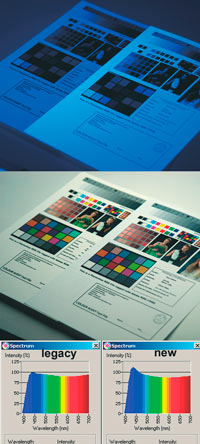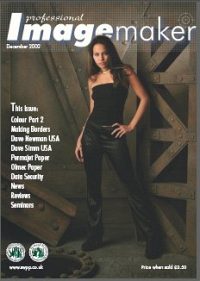articles/Paper/olmecgoeswhiterthanwhite-page1
Olmec goes Whiter than White - part 1 of 1
by Mike McNamee Published 01/12/2002

The secet of Olmec's new found whiteness is evealed by the ultra violet light. On the left in the viewing booth a fine art OBA free paper and on the right Olmec 260gsm Satin. The spectro traces below show more clearly the lift at the blue end of the spectrum.
Olmecpapers are made by ICI Imagedata and have been around for some time now, gathering a substantial number of devotees. We have tested it before with good results and were interested to look at two new offerings, the 260gsm Photo Quality Satin and Gloss. The claims made for the new formulation are that it is whiter, saves on ink by using Film media settings rather than Glossy Paper and has an all round better coating. Specifically the coating is 4-layer and more gas tight, leading to less bleed and higher light fastness.
They are billed as ultra white and boy do they mean it! The image shows a comparison of a fine art paper and Olmec Satin in both D65 (equivalent to overcast daylight) and ultra violet light. The optical brightener is probably the brightest that we have seen and it certainly gives the print a considerable zest. The spectro traces confirmed the high OBA activity. It is from this higher reflectivity in the low wavelengths that the increased brightness claim is justified. In reality it looks whiter but is more blue and actually has a lower reflectivity than its older cousin and is effectively three times further from the neutral point. The older material actually lay in the cream (yellow) part of the Lab plot whereas the new are cyan.
Both new papers are similar in structure. They are 26 micron in thickness, about 4 microns thicker than photographic paper and weigh in a 260grams per square metre (gsm). The base colour is cool white, a blueness which transmits to the higher end of the grey scale where there is little ink to hide the underlying paper colour. The ink receptive surface is a micro porous resin coating which is classed as "instant dry". In the Epson 1290 we used it was dry as it came out of the printer. The Satin finish is a delicate stipple which is pleasing to the eye. Both papers hold the ink quite close to the surface and even with the recommended ink setting of "Glossy Film" the maximum black density was a very deep and rich 3.94%. Overall the brightness and "sparkle" of the prints are assisted at both ends of the scale. The surface is rated for both dye and pigmented ink sets with the exclusion of the Epson 2000P. We did test it with Generations MicroBright inks and it smeared very badly. More extensive testing will be carried out with the latest pigment based Epson UltraChrome ink set in due course.

You can't really show the resolution of the paper on a printed page but it is very high, with just enough bleed to allow the droplets to merge into a smooth finish. Lettering 1.5mm high was readable through a 20x loupe.
We made prints using standard Epson 1290 Drivers and bespoke profiles. As we have usually found, the Epson drivers produced a pleasing if slightly desaturated result, with a greyscale that retained detail right down into the deepest shadows. The bias of the greys was towards cyan, expected from such a heavily optically brightened paper; indeed the point in the grey scale furthest from neutrality was the base white, the profile build put yellow onto the print at the first opportunity!
The overall profiled colour error was 8 Lab Delta E points on the current material compared to 6 on the legacy Olmec stock we measured. However the hue errors in the newer material were more aligned towards the white point, which gives a more pleasing result regardless of what the statistics say! For the record the Delta E 2000 errors over the Macbeth Chart were 1.5, 2.9 and 2.8 respectively in the lightness, saturation and hue components. Visual assessment of the print rated it as first class, very slightly less saturated than a reference print made onto Epson Premium Glossy but slightly more neutral. Examination in D65 lightening and tungsten lighting was equally pleasing.
Overall this is an excellent paper for prints in which you are seeking the maximum impact, the images really bounce off the page! If you are looking for a more true art feel then look elsewhere, however many people will rate the extra zip as having more inherent quality. These are two papers you should at least try to see if you like them.
The paper is available in sheet sizes A6+, A4, A3 A3+ and A2 from 20 to 50 sheet boxes. Silverprint are quoting the 260gsm paper at around 43p per A4 sheet but check your prices.
You are currently on page 1 Contact Mike McNamee
1st Published 01/12/2002
last update 09/12/2022 14:57:05
More Paper Articles
There are 15 days to get ready for The Society of Photographers Convention and Trade Show at The Novotel London West, Hammersmith ...
which starts on Wednesday 14th January 2026





